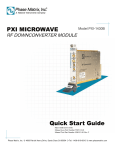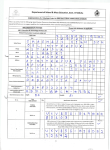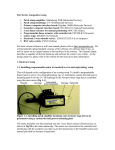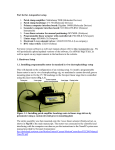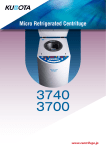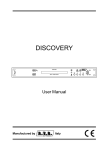Download American Dynamics 1461 Operating instructions
Transcript
Model 1461 Single Channel Motion Detector Installation and Operating Instructions The 1461 is an analog device for the detection of motion in the field of view of a TV camera. It is intended as an aid to personnel engaged in monitoring a TV display and is not intended as a primary alarm input device. The software/firmware furnished with this equipment is confidential to and is copyrighted by AMERICAN DYNAMICS. It is not to be copied or disclosed in any manner without the express written consent of AMERICAN DYNAMICS. The software/firmware is furnished to the purchaser under a license for use on a single system. Note: Information furnished by AMERICAN DYNAMICS is believed to be accurate and reliable. However, no responsibility is assumed by AMERICAN DYNAMICS. for its use; nor for any infringements of other rights of third parties which may result from its use. No license is granted by implications or otherwise under any patent or patent rights of AMERICAN DYNAMICS. = =- AMERXfAN -=L-‘DYNRM/CS The installation of this product should be made by qualified service personnel and should conform to all local codes. symbol, within an equilateral triangle, is intended to alert the user to the presence of product’s enclosure that may he of sufficient magnitude to constitute a risk of electric shock to persons. CAUTION: To reduce the risk of electric shock, do not remove covers (or back). No user-serviceable parts inside. Refer servicing to qualified service personnel WARNING To reduce the risk of fire or shock hazard, do not expose this product to rain or moisture. Warning: This product generatesuses, and can radiate radio frequency energy and if not installed and used in accordance with the instruction manual, may cause interference to radio communications. It has been tested and found to comply with the limits for a Class A computing device pursuant to Part 15 of FCC Rules, which are designed to provide reasonable protection against such interference whrn operated in a commercial environment. Operation of this product in a residential area is likely to cause interference in which case the user at his own expense will be required to take whatever measures may be required to correct the interference t l n The exclamation point within an equilateral triangle is intended to alert the user to the presence of important operating and maintenance (servicing) instructions in the literature accompanying the product. UNPACKING AND INSPECTION Unpack carefully. This is an electronic product and should be handled as such. Compare the items received with the packing list with your order. Be sure to save: 1. The shipping cartons and insert pieces. They are the safest material in which to make future shipments of the product. 2. The IMPORTANT SAFEGUARDS sheet. 3. These Installation and Operating Instructions. MAINTENANCE User maintenance of this unit is limited to external cleaning and inspection. For specific recommendations refer to the IMPORTANT SAFEGUARDS sheet packaged with this product. INSTALLATION AND SERVICE If you require information during installation of this product or if service seems necessary, contact the Sensormatic Video Products Division at (619) 6422400. You must obtain a Return Authorization Number and shipping instructions before returning any product for service. Do not attempt to service this product yourself. Opening or removing covers may expose you to dangerous voltages or other hazards. Refer all servicing to qualified personnel. QA30lD Table of Contents Product Description . . . . . . . . . . . . . . . . . . . . . . . . . . . . . . . . . . . . . . . . . . . . . . . . . . . . . . . . . . . . . . . 1 Features . . . . . . . . . . . . . . . . . . . . . . . . . . . . . . . . . . . . . . . . . . . . . . . . . . . . . . . . . . . . . . . . . . . . . . . . . . . . . . . . . . 1 Installation . . . . . . . . . . . . . . . . . . . . . . . . . . . . . . . . . . . . . . . . . . . . . . . . . . . . . . . . . . . . . . . . . . . . . . . . . . . . . . 1 Connections . . . . . . . . . . . . . . . . . . . . . . . . . . . . . . . . . . . . . . . . . . . . . . . . . . . . . . . . . . . . . . . . . . . . . . . . . . . . 2 Operation................................................................................ Operating Controls ...................................................... Setup ............................................................................ Normal Operation ....................................................... 3 3 4 .4 Appendix System Considerations ................................... ............ A Typical System Connections ...................................... .C DESCRIPTION DISPLAY BYPASS AUTO RESET Figure 1 - 1461 Front Panel PRODUCT DESCRIPTION INSTALLATION The 1461 is an analog device for the detection of motion in the field of view of a TV camera. It is intended as an aid to personnel engaged in monitoring a TV display and is not intended as a primary alarm input device. Systems involving video motion detectors must use the best possible connection and grounding practices. Poor wiring not only causes poor pictures, but could affect the alert function. Camera and lens selection, camera location, scene lighting, and mounting are also significant factors in achieving optimum performance. These factors are covered in more detail in the Appendix, System Considerations. Only standard video from a camera is required. No external sync drives are necessary. The video input is passively looped to the output to allow the motion detector to be turned off with no loss of video. Mounting The 1461 switcher is supplied as a desk-top unit. Place the unit in a position convenient for the operator, usually adjacent to the monitor to be viewed. For rack mounting, 2117 Series rack-mount kits are available. The 1461 is a quarter-rack unit. Up to four quarter-rack units such as a 1461 or a 1404A Sequential Switcher may be mounted in a single 19” by 1 314” rack. One or two may be mounted with half rack units such as the 1440B Date/Time Generator. The successful operation of video motion detectors depends on many factors. The section on SYSTEM CONSIDERATIONS in the Appendix should be reviewed before finalizing a system. . FEATURES * MULTIPLE ALERT ACTION * ADJUSTABLE DETECTION AREA * ADJUSTABLE SENSITIVITY IF YOU ENCOUNTER ANY PROBLEMS OPERATING THIS UNIT, OR NEED TECHNICAL ASSISTANCE, CALL: * AUTO-COMPENSATION FOR SLOW LIGHT LEVEL CHANGES Sensormatic Video Products Division 6795 Flanders Drive San Diego, CA 92121 * MANUAL OR AUTOMATIC RESET * FRONT PANEL CONTROL Tel: 619-642-2400 Fax: 619-642-2440 1 CONNECTIONS 12ov 60HZ CONTROL 0 Figure 2 - 1461 Rear Panel CONNECTIONS Auxiliary Start Relay Connections Video Input The 5-pin CONTROL connector is also used to access a normally open, SPST relay which can be used to activate a VCR or other devices during an alert. The relay contacts provide a closure between pins 3 and 4 when an alert condition occurs. CAUTION: DO NOT USE THIS RELAY TO SWITCH LINE VOLTAGES. The relay contact ratings are: Connect a good grade of RG59/U video cable from the camera to the VIDEO IN BNC Connector on the rear panel of the 1461. The 1461 has a passive loop-thru input. It does not terminate the input in 75 ohms. The video input cable should be terminated in 75 ohms at the end of the run. Power: Voltage: Current: Video Output Connect a good grade of RG59AJ video cable from the VIDEO PUT BNC connector on the rear panel of the 1461 to the video input of the monitor or video switcher. This cable should be terminated in 75 ohms, or if looped thru the monitor or switcher, terminated at the end of the run. . Power The model number and rated power are shown on the rear panel of each unit. No power On/Off switch is provided. The LED on the front panel is lit when power is applied to the unit. Automatic Switcher Call-Up Connections Connections to an external switcher are made at the CONTROL connector on the rear panel of the 1461. Pin 2 provides a logic-level closure during an alert for remote call-up of a switcher. A typical system connection for switcher call-up is shown in the Appendix. The CONTROL connector pin definitions are: PIN1 PIN2 PIN3 PIN4 PIN5 10 VA max. 30 VDC or RMS max. 0.25 A DC or RMS max. (resistive load) Model 1461 - 120 VAC, 60 Hz nominal. Insert the pendant 3-wire cord and plug into a mating power source. Model 1461101 - 13.5 V DC (11 to 18 VDC). Attach the leads extending from the rear panel to the power source. A separate chassis ground terminal is also provided. Ground Switcher Logic Out Auxiliary Relay Contact Auxiliary Relay Contact No Connection Red Wire with Fuse Holder - (+) (hot) lead. Black Wire - (-) (ground) lead. Model 1461X - 230 VAC, 50/60 Hz nominal. Insert the pendant 3-wire cord and plug into a mating power source. Pin 1 is at the top of the connector, see Figure 2. A mating 5-pin plug is provided. Note that this plug also provides connections for the auxiliary start relay. 2 OPERATION -@+ -@+ -@+ DISPLAY BYPASS AUTO RESET Figure 3 - 1461 Front Panel Controls OPERATION DISPLAY (+/-) - This two position toggle switch activates (+) or deactivates (-) display of the two vertical bars indicating the area of the picture in which motion is detected. (See Figure 4, On-Screen Display, page 4.) It does not otherwise affect the operation of the unit. The activated (+) position is normally used unless public display of the area in which motion is being detected is inadvisable. Operating Controls All operating controls are on the front panel of the 1461, as shown in Figure 3. Power ON LED - This LED is lit when power is applied to the unit. BYPASS (+/-) - This toggle switch activates (+) or deactivates (-) the audio alert, the switcher call-up logic output and the auxiliary start relay functions of the motion detector. It must be in the activated (+) position when these functions are desired. The visual ALERT LED’s are not affected by the position of the BYPASS switch. In the deactivated (-) position, when an alert occurs the LED’s flash, but the audio signal, the switcher logic, and the relay are not active. ALERT LEDs - These two LEDs flash alternately when motion has been detected, until turned off by AUTO RESET or by a manual RST (Reset). RST (Reset) Button - After an alert has been indicated this button restores the unit to the motion detection mode and stops all alert signals. If the motion is still detected, the unit returns immediately to the alert condition. The manual RST function is available regardless of the AUTO RESET switch setting. AUTO RESET (+/-) - This toggle switch activates (+) or deactivates (-) the automatic reset of the motion detector. When activated (+), an alert condition automatically is cleared 12 seconds after motion ceases. When deactivated (-), the manual RST must be used to clear an alert condition. SENS (Sensitivity) - This screwdriver control adjusts the sensitivity of the active detection area. Clockwise rotation increases sensitivity. VERT (Vertical) P and S - These recessed screwdriver controls adjust the vertical position and size of the rectangular detection area. The P control adjusts the vertical position and the S adjusts the vertical size of the area. HORIZ (Horizontal) P and S - These recessed screwdriver controls adjust the horizontal position and size of the rectangular detection area. The P control adjusts the horizontal position and the S adjusts the horizontal size of the area. 3 OPERATION Setup Normal Operation 1) Apply power to the motion detector and associated cameras, switchers, and monitors. It is normally better to have power to auxiliary equipment, such as VCR’s, off during initial setup. During normal operation the motion detector should be set with all toggle switches in the active (+) position. This displays the detection area enclosed by twin vertical bars, arms the four action indicators, and enables the auto reset. It allows the operator to look away from the monitor yet readily locate the detection area on the screen. Motion alerts will activate all alert functions. The unit will automatically reset to the detection mode 12 seconds after the detected motion ceases. If the operator wishes to turn the alert indicators off and reset sooner, the manual reset button (RST) can be used. 2) If necessary, adjust the switcher to display the camera video which is to be monitored by the motion detector. 3) Turn all three motion detector toggle switches to the deactive (-) positions. If the motion detector is used on a critical area during a noncritical time period, such as a doorway at quitting time, the BYPASS switch may be set to the deactive (-) position. In this mode the LED’s will flash, but the audio signal, the relay, and the switcher logic will not activate. 4) Turn the DISPLAY switch to active (+). Note the twin vertical bars, as shown in Figure 4, On-Screen Display. These bars define the rectangular area of the picture within which motion is detected. The size of this area may be adjusted using using the front panel screwdriver controls for vertical (VERT) and horizontal (HORIZ) position (P) and size (S). Set the sensitive area to cover the region of the picture within which motion is to be detected. 5) Turn the BYPASS switch to active (+). This activates the four alert functions. Motion in the sensitive area causes: - the visual ALERT LED’s to flash alternately, - the audio beeper to sound, - the auxiliary start relay contacts to close, and - the switcher logic output to go active low. 6) Ensure that the AUTO RESET switch is in the deactive (-) ‘X position before proceeding with Step 7. This allows sensitivity to be adjusted without the interference of an automatic reset. DETECTION AREA 7) Sensitivity; the most critical adjustment, is adjusted using the screwdriver control SENS. The setting should be low enough to avoid false or unwanted alerts caused by normal motions such as birds or blowing trees, but high enough to detect motions of interest. The optimum setting is best determined by experiment at the site at which the 1461 is to be used. Start with the as-shipped, midrange setting. Simulate anticipated motions which should and should not cause an alert. If the results are unsatisfactory: raise (CW) or lower (CCW) the sensitivity, reset the unit with the RST button, and repeat the simulated activity until satisfactory performance is obtained. Figure 4 - On-Screen Display 8) Turn the AUTO RESET switch to active (+). This is the normal operating mode. In this mode the unit automatically resets 12 seconds after detected motion ceases. 4 APPENDIX SYSTEM CONSIDERATIONS SYSTEM CONSIDERATIONS Motion detectors operate on the principle that any change in the scene from a camera is caused by some moving object. They monitor the content of a camera scene within a sensitized area and detect differences in the scene content in that area from one TV frame to the next. Moving objects in the sensitized area in the field of view cause video changes in that area which, depending on the setting of the sensitivity, cause alerts. However, particularly in outdoor installations, normal motions such as blowing leaves, small animals, birds, or clouds may cause unwanted alerts. Other factors such as instability in the camera, rapid changes in light level caused by an autoiris, jitter caused by camera interlace, or electrical noise signals superimposed on the video signal by improper cabling or poor grounding will also cause changes in the scene content and produce false alerts. The sensitivity adjustment establishes the amount of change in scene content that is required within the sensitized area before the unit produces an alert. Reducing the sensitivity will reduce unwanted or false alerts. However, sensitivity to desired alert conditions is then also reduced. Other important system considerations for achieving optimum motion detector performance are discussed below: magnifies objects in the scene but covers a smaller area. A short focal length (wide-angle) lens covers a large overall scene, but shrinks the apparent size of objects in the scene. Motion detectors can be affected by lenses of either too short or too long a focal length. A long focal length (telephoto) lens is often used outdoors to view more distant areas. These lenses also magnify the effects of camera motion. When used, the camera must be stably mounted. Avoid unsteady towers or poles. Telephoto lenses also magnify the disturbances caused by atmospheric effects, such as the image “swimming” seen when hot air currents cause air density changes in the path between the camera and the scene. Image interruption by snow, rain, and fog is obviously more frequent when the camera is very distant from the scene being viewed. All these factors limit the total distance that can be covered, the lens focal length and the utility of motion detectors on outdoor scenes. They must be judged by the installer after determining the operating environment for each camera. A short focal length (wide angle) lens is used where the camera is close to the scene, and a greater field of view is needed. Objects in the scene appear smaller on the monitor and to the motion detector. Very small objects are more difficult for the motion detector to sense. There is, therefore, a limit to the coverage advantage of wide angle lenses. Camera Selection .: The 1461 may be used with both 2:l interlace and random interlace cameras. No external sync drive from the camera is required. These features are unusual in motion detector systems. The field of view and magnification of a given focal length lens also depends on the image format (size) of the camera tube. Tables or formulas are usually available from the camera or lens supplier. Nevertheless, camera selection is very important. The selected cameras should be electrically and mechanically stable, lownoise, high quality units for best performance. These factors can affect the number of cameras needed in a given installation. They should be determined by calculation or experiment during the initial design of the video system. In general, random interlace cameras will give a lower level of performance than 2: 1 interlace cameras. Small disturbances of the image are inherent with random scanning. These disturbances may be interpreted by the motion detector as object motions. Consequently, a unit using random interlace cameras will require a slightly lower sensitivity setting to minimize false alerts. Lens Aperture - The aperture (f-number) of a lens is a measure of the maximum lens opening available to pass light to the camera. It is thus also a measure of the relative performance of a camera/lens combination at low light levels. Low light level performance is affected by the camera type. Large apertures are indicated by small f-numbers (for example, f/l .4). Lens Selection As the light level on a scene drops, the possibility of both increased picture noise and reduced video signal increases. Increased picture noise, especially low frequency noise, increases the probability of false alerts and may necessitate a reduction of the sensitivity setting. Reduced video signal directly reduces the apparent sensitivity of the motion detector. These factors ultimately limit the degree of scene darkness at which the motion detector will operate. Video motion detector systems are affected primarily by three lens parameters: Focal length, Aperture, and Iris Control Method. Focal Leneth - The focal length of a lens directly affects the apparent size of objects as seen on the monitor and by the motion detector, Focal length also affects the overall field of view of the camera. A long focal length (telephoto) lens A SYSTEM CONSIDERATIONS A target may move so slowly that its motion is not perceived by the unit. A longer focal length lens magnifies both size and apparent speed of motion. The performance of various camera-lens combinations at different light levels may be obtained from the manufacturer’s data. For optimum performance, the 1461 requires a moderately noise-free video signal at industry standard voltage levels. The camera-lens combination should be selected more conservatively than is normal in installation not using motion detectors. A target may move through the scene so rapidly that its presence is missed by the camera, and thus by the system. This condition is very unusual but may often be corrected by camera positioning and lens selection. Iris Control Method - Some auto-iris lenses, exhibit characteristics requiring special consideration when used with video motion detectors. With these lens, large light or dark objects, moving in the field of view, near but outside the sensitive window area of the motion detector, may open or close the lens rapidly enough to cause undesired alerts. In any given installation, these factors should be determined during installation planning. If necessary experiments under actual operating conditions should be conducted. False Alerts and Misses When such a lens is used, the camera placement must be such that normal movements in the scene do not cause the auto-iris to open or close rapidly. This can usuahy be accomplished by ensuring that there are no light areas of the scene which could be blocked by permissible movements. Mounting the camera high enough to obtain a neutral scene background will usually suffice. Common causes of excessive false alerts are: sensitivity control set too high, loose or defective coaxial video connectors or cables, spurious moving objects or lights in the camera field of view, camera ALC setting too high, unnoticed shadows, flickering fluorescent lights, etc. Common causes of excessive misses are: sensitivity control set too low, object in motion is too fast or too slow, object in motion is too small to effect sufficient video change, etc. The automatic iris lens should be adjusted for “average”, rather than “peak’ response to avoid over-reaction of the lens to very small bright objects. When adjustable, the time delay of the auto-iris should be set as long as possible, to avoid short transient reactions of the iris to brief light changes. If false alerts and misses continue to be a problem, the entire installation should be reexamined. Installation changes to improve performance may be possible. Such changes may include: relocation of the camera, change of lens, change of lighting, or addition at different locations of other cameras and motion detectors to cover a wider variety of motions. -Some auto-iris lenses are subject to “hunting” (a tendency to continuously open and close a small amount while searching for the optimum iris aperture). This effect is often visible in the image as a slowly pulsating overall brightness of the monitor image: The 1461 will tolerate a small amount of lens hunting. Excessive hunting usually indicates a problem with the iris control mechanism which should be corrected. Detectable Targets The detectability of a moving object is determined by its size, contrast with the background, and speed of motion. Once an object appears larger than approximately 3% of the monitor screen dimension, or 0.1% of the screen area, its detectability will not increase greatly. Therefore, the best trade-off of area coverage against sensitivity occurs when the lens and camera position are selected to give this size for objects of interest. When maximum detection probability is desired a slightly longer focal length lens may be used. In order to detect an object it must have some visual contrast with the scene background. Contrast may be enhanced by improved lighting and by positioning the camera so that the targets appear against a background of contrasting color. For most targets, a light background provides the highest contrast. B TYPICAL SYSTEM CONNECTIONS 1461 Motion Detectors to 1408A Switcher 1461 MOTION DETECTORS CONTROL IN OUT 5 CAMERA 4 30 : . . REMOTE START -. ---L 1L -oc CAMERA 1 m 1408A SWITCHER REMOTE START lo 0 0 01 TIME-LAPSE VCR MONITOR C Local VCR NOTE: Impedance of local VCR and MONITOR must be set to HI-Z -I ) 0 - Lozal MONITOR SPECIFICATIONS Voltage Supply: 1461 - 120 VAC, 50/60 Hz 1461101 - 13.5 VDC (11 to 18 V) - 3/8 Amp Slo-Blo fuse 1461X - 230 VAC, 50/60 Hz Power: 3 watts Aux Relay Contacts: Power - 10 VA max Voltage - 30 VDC or RMS max Current - 0.25 Amps DC or RMS max. (resistive load) Video Input: Passive looping, 525 line, 60 Hz “X” Models are 625 line, 50 Hz Sensing Area: - Minimum - 0.8% of Scanned Area Maximum - 90% of Scanned Area Size: 1.75” H x 4.3” W x 7.2” D (45 x 110 x 183 mm) Weight: 1.8 lbs (0.8 kg) Designed and built by AMERICAN DYNAMICS 10 Corporate Drive Orangeburg, New York 10962 Service Center: 619-642-2400 FAX: 619-642-2440 OP1461C May 1996 Printed in USA















